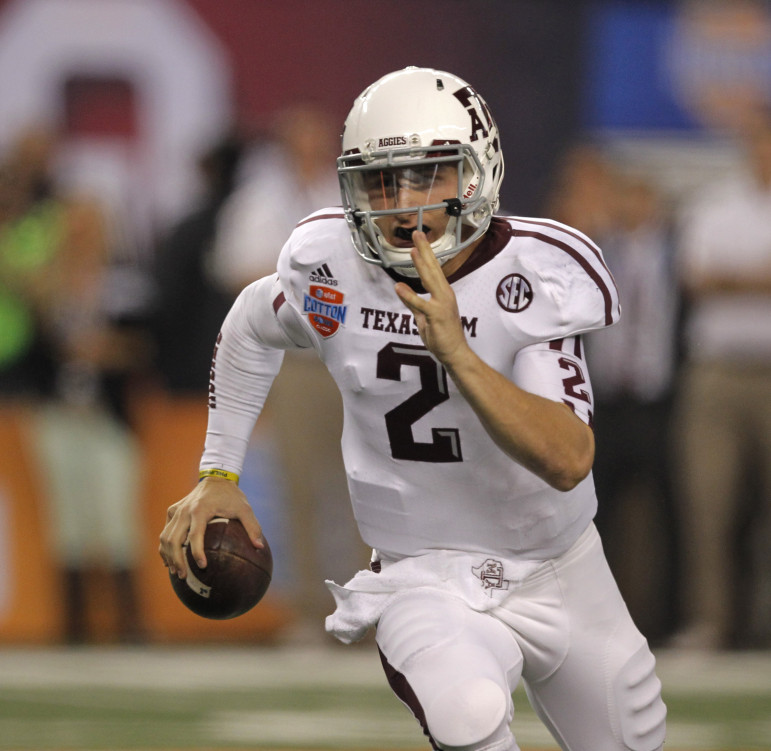
Rodger Mallison / Fort Worth Star-Telegram/MCT
Texas A&M quarterback Johnny Manziel (2) takes a break from signing photos of himself while he runs for a 5-yard touchdown in the second quarter against Oklahoma in the AT&T Cotton Bowl game in Cowboys Stadium in Arlington, Texas, on Friday, January 4, 2013.Telegram/MCT
The online database website ArrestNation tracks law-breaking incidents among athletes.
In 2012, the site tallied more than 500 arrests, citations and charges across a broad spectrum of sports, from pro basketball to minor league baseball. But one sport dominated the list, representing more than half of counted incidents: college football.
During the 2012 offseason -- which ran from Jan. 10, 2012, the day after the BCS Championship Game, to Aug. 29, 2012, the day before the first day of the 2012 NCAA football season -- approximately 150 active college football players were arrested, cited or charged with offenses, according to ArrestNation.
The list of charges involving college football players run the gamut from traffic violations such as driving without a license, to criminal sexual assault and forcible rape. The names on the list represent everyone from bit players on uncompetitive BCS teams such as Montana State all the way up to last year’s Heisman Trophy winner, Johnny Manziel (who was busted for disorderly conduct and possessing a fake ID by College Station, Texas police).
After the BCS Championship game in January 2013, which saw SEC titan Alabama crush a resurgent Notre Dame squad 42-14, the Associated Press posted its final “Top 25” ranking for the NCAA Division I football season. Combined, close to 40 players from the teams on that list had been arrested during the 2012 offseason, resulting in an average of 1.44 player arrests per team.
In an e-mail exchange, a representative from ArrestNation (who wished to remain anonymous) didn't see a connection between on-field dominance and off-field criminality.
“There are many contributing factors or reasons for a team’s success such as athletic ability, training, coaching, facilities, player dedication, hard work and so forth,” the spokesperson wrote. “Player arrests are off-the-field incidents based on behavioral activities and/or poor decisions … keep in mind, many successful teams each year go without an arrest.”
According to an ArrestNation representative, the disproportionate number of college football players who are arrested on an annual basis may be explained by a host of factors.
“Any disproportionality of NCAA college football arrests of student-athletes may stem from the disproportionality in the total number of NCAA college football players and the large roster size of a football team as compared to all other college teams and rosters,” the ArrestNation source said.
David Willig, a Miami-based attorney and founder of American International Sports Management, LLC, said he had doubts as to whether college football players are even arrested at rates exceeding national averages. For comparative purposes, the FBI attributed about 18 percent of all charges to individuals ages 18 to 21 in its 2011 Uniform Crime Report. (Remember, the ArrestNation folks say their statistics are incomplete, so there’s no easy way here to do any kind of comparison to national statistics.)
“It’s not surprising if the numbers are a little high, but I’m not sure they’re higher than the population as a whole,” Willig said. “I’ve looked at studies that compare the arrest rates for NFL football players. … If you lay those figures over the figures for the population as a whole, they’re actually lower.”
Willig suggests the seemingly disproportionate arrest rates for football players, both on the college and professional level, can be attributed to the athletes’ youth. Traditionally, he said, football players tend to fall into the demographic that, overall, is the most frequently arrested in America -- young men, between the ages of 18 and 29.
While college players sometimes do get arrested for serious offenses, like major property crimes and crimes that result in the serious injury of others, Willig said a majority of college arrests stem from lesser violations.
“Young men do get involved in fights,” Willig said. “They’re on the cusp of adulthood, and they’re just experimenting with things like alcohol and sexual relationships, [and] sometimes in that learning process, things do go awry.”
He brings up a recent New York Times analysis that found roughly a third of the players on Urban Meyer’s 2008 National Champion Florida Gators roster had either been arrested while attending the University of Florida or after leaving.
“Look at the crimes that are actually reported,” Willig said. “Half of those arrests were for what I would call ‘adolescent hijinks.’”
Willig brings up Florida linebacker Antonio Morrison, who was recently arrested for barking at a police dog.
“Sure you shouldn’t interfere with the police,” he said. “But that’s the kind of arrest that kind of makes people laugh more than worry ‘wow, what’s happening to our youth?’”
[Editor's note: This story is condensed from a previous version.]